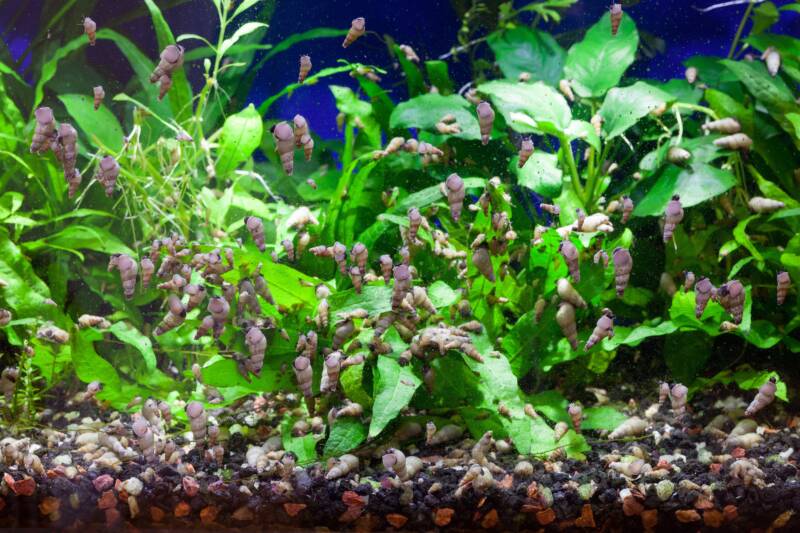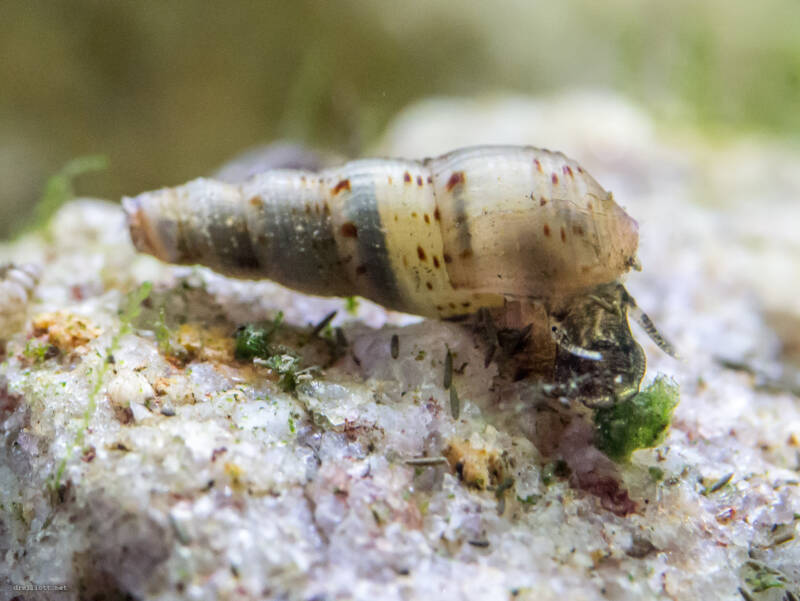Malaysian trumpet snails are one of the most common types of aquarium snails available in the hobby.
In fact, they’re so common that some pet stores choose to give them away for free with the purchase of live fish or plants.

These snails are known as the Malaysian burrowing snails, Malaysian livebearing snails, MTS, trumpet snails, and trumpets.
And just like they have many names, they also serve many purposes in the aquarium.
They serve as part of the “clean-up” that keeps the tank spic and span outside of regular water changes.
They also can be just as interesting to watch as finned tank inhabitants.
[toc]
At a Glance
| Min tank size: | 5 gal (20 l) |
| Lifespan: | up to 5 years |
| Breeding: | reproduce easily and quickly |
| Lifespan: | 1 year |
| Size: | 0.8-1.5 inches (2-4 cm) |
| Temperature: | 70-80°F (21-27°C) |
| pH: | 6.0-7.5 |
| Hardness: | 4-15 dH |
| Ammonia and nitrite: | < 2 ppm |
| Nitrate: | < 5 ppm |
Shell Appearance and Snail Lifespan
Like all snails, Malaysian trumpet snails have a shell on their “back.” Their shell is elongated and resembles an ice cream cone, with swirling rings that gradually move upward to form a pointed apex at the top of the shell.
The shells may be solid colors or patterned, with colors ranging from white to pinkish, to yellow, to even brown and gray. Generally, shells grow to roughly an inch in length and one-sixth inch in diameter.
This shell appearance often leads to them being mistaken for red-rimmed Melania snails (Melanoides tuberculata), which also have conical shells.
However, as their name so aptly hints at, red-rimmed snails have red spots and undertones on their shells, which are otherwise a green or brown hue.

The mouth of these snails can extend comparatively far beyond its body, resembling a tiny elephant trunk, appearing when digging and reaching for food.
Malaysian trumpet snails are generally active and like to keep moving— so many plants to clean, so many fish to see.
And when they choose to stick to hard surfaces, they can be hard to remove. Motionless snails or ones that are laying upside down are unhealthy snails and should be treated or removed from the tank.
Unfortunately, these snails only live roughly one year. Some aquarists have reported longer lifespans when kept with high water quality.
But Malaysian trumpet snails will never outlive the other tank inhabitants.
Behavior and Temperament
During the day, Malaysian trumpet snails prefer to spend their time underneath the tank substrate.
Here, they can forage for food and even burrow down to the very bottom of the tank.
When the tank lights are off or dim, trumpet snails will emerge from the substrate to examine the other tank surfaces for food.
Trumpet snails are peaceful creatures that do not show aggressive tendencies.
They get along with other fish, their own species, and even other snails such as the nerite snail. (Though, for obvious reasons, they try to avoid assassin snails.) Because of this, they do well in all types of tropical community tanks.
One aspect of the Malaysian trumpet snail that can either be considered an asset or hindrance is its capability to reproduce.
These snails reproduce easily and quickly in environments where there are good water quality and plentiful food.
In fact, they reproduce a bit too successfully in some tanks, which is why hobbyists can have serious problems with population control.
Setting Up an Aquarium with MTS
If kept alone, these snails may be housed in aquariums with a minimum of 5 gallons, but preferably 10 gallons.
Smaller gallon sizes result in unstable water parameters and accidental recycling. This is why it’s generally better to have larger tanks.
Keepers should also remember that, though small, Malaysian trumpet snails do have their own bioload.
When kept in a community tank, the aquarium should be the size most befitting the largest inhabitant.
These snails can be added to almost any size community tank. But aquarists should also be sure adding these snails will not cause overstocking issues.
Equipment Considerations
Few aquarists keep species-only tanks for Malaysian trumpet snails, especially when they’re not being used as food for another fish.
But when introduced into a community tank, where MTS can otherwise easily thrive, hazards may arise.
- Filtration: Strong filter intakes have been known to suck up Malaysian trumpet snails, whose shells become stuck in the intake valves or slats. Adding sponge pre-filters over the intakes can help avoid this problem.
- Temperature: They need warm water, so a heater and thermometer are a must in order for them to successfully thrive. Do well in tropical tanks but aren’t suited for cold water environments.
- Substrate: Because of their short lifespan, it’s wise to buy light-colored snails if you have a dark substrate or vice versa; this way, when the snail dies, tank owners can easily spot and remove it.
- Tank Dosing: Be careful when using plant fertilizers, medications, and nutrients in-tank dosings. Though beneficial for other tank mates, many elements in these can be fatal to snails, especially copper.
On their own, Malaysian trumpet snails are fairly easy to keep. They don’t like a strong current, need warm water, and enjoy having live plants to clean.
However, several problems can arise when introducing them into community tanks.
Water Parameters and Preferences
Regular water changes are a must, especially since these snails are often kept in community tanks.
They are fairly hardy but are still negatively affected by waste, dead plant matter, and excess food.
But with clean water and the proper pH and temperature ranges, these snails are easy to care for.
- pH Range – These snails prefer water within the 7.0 – 7.5 pH range, and tend to like it better if the water is also on the hard side.
- Temperature – Like many tropical species, Malaysian trumpet snails like water in the ‘70s and even low ‘80s.
Most tank inhabitants are susceptible to ammonia, nitrites, and nitrates, and this snail is no exception.
Though they can survive higher levels of up to 5 ppm, all fish and snails thrive when the aquarium has low or nonexistent levels of 0 – 2 ppm.
Malaysian Trumpet Snail Food and Diet
https://www.youtube.com/watch?v=djZAmaowxa8
Calcium is the most important part of a Malaysian trumpet snail’s diet. It is required for healthy shell growth, which in turn ties into the snail’s overall health.
Besides calcium, Malaysian trumpet snails are fairly self-sufficient eaters.
They are avid foragers and will spend most of their time digging through the tank substrate. Some of their favorite foods include:
- Uneaten fish food
- Fish flakes or pellets
- Algae wafers
- Bottom feeder tablets
- Soft algae
- Live plant material
These snails will quickly gobble up any and all of the foods listed above, making them the perfect addition to a community tank clean-up crew.
They are also less destructive and aggressive than many other bottom feeders or algae eaters, both in terms of their interactions with other fish and plants.
Malaysian trumpet snails get along with all fish and only eat debris that live plants shed, not the live plants themselves.
Deciding to Buy a Trumpet Snail
Malaysian trumpet snails are an excellent choice for all types of aquarists, whether they are new to the hobby or old pros. These snails do well in a range of environments.
They get along with a variety of other fish, crustaceans, snails, invertebrates, and other peaceful tankmates.
MTS are industrious cleaners that don’t require much upkeep and are also aesthetically pleasing. Thus, it is both a pleasure to watch them work and to own them in general.
